Business Law Assignment: Contract, Tort, Negligence, and Liability
VerifiedAdded on 2021/04/15
|16
|4121
|33
Report
AI Summary
This business law assignment provides a comprehensive overview of key legal concepts essential for business operations. It begins by outlining the essential elements of a valid contract, including offer, acceptance, consideration, and capacity, while also addressing scenarios that may render a contract defective. The report then delves into different types of contracts, such as distance selling, written, and verbal agreements, and explores potential challenges associated with each. The importance of various terms within a contract, including conditions, warranties, and express terms, is thoroughly explained with relevant examples. Furthermore, the assignment differentiates between contractual liability and liability in negligence, providing insights into tort law and vicarious liability. The report also explores anticipatory repudiation and remedies for breach of contract, offering a complete understanding of contract and tort law principles. References are provided for further reading.

(Student Name)
(University Name)
(Date)
(University Name)
(Date)
Secure Best Marks with AI Grader
Need help grading? Try our AI Grader for instant feedback on your assignments.
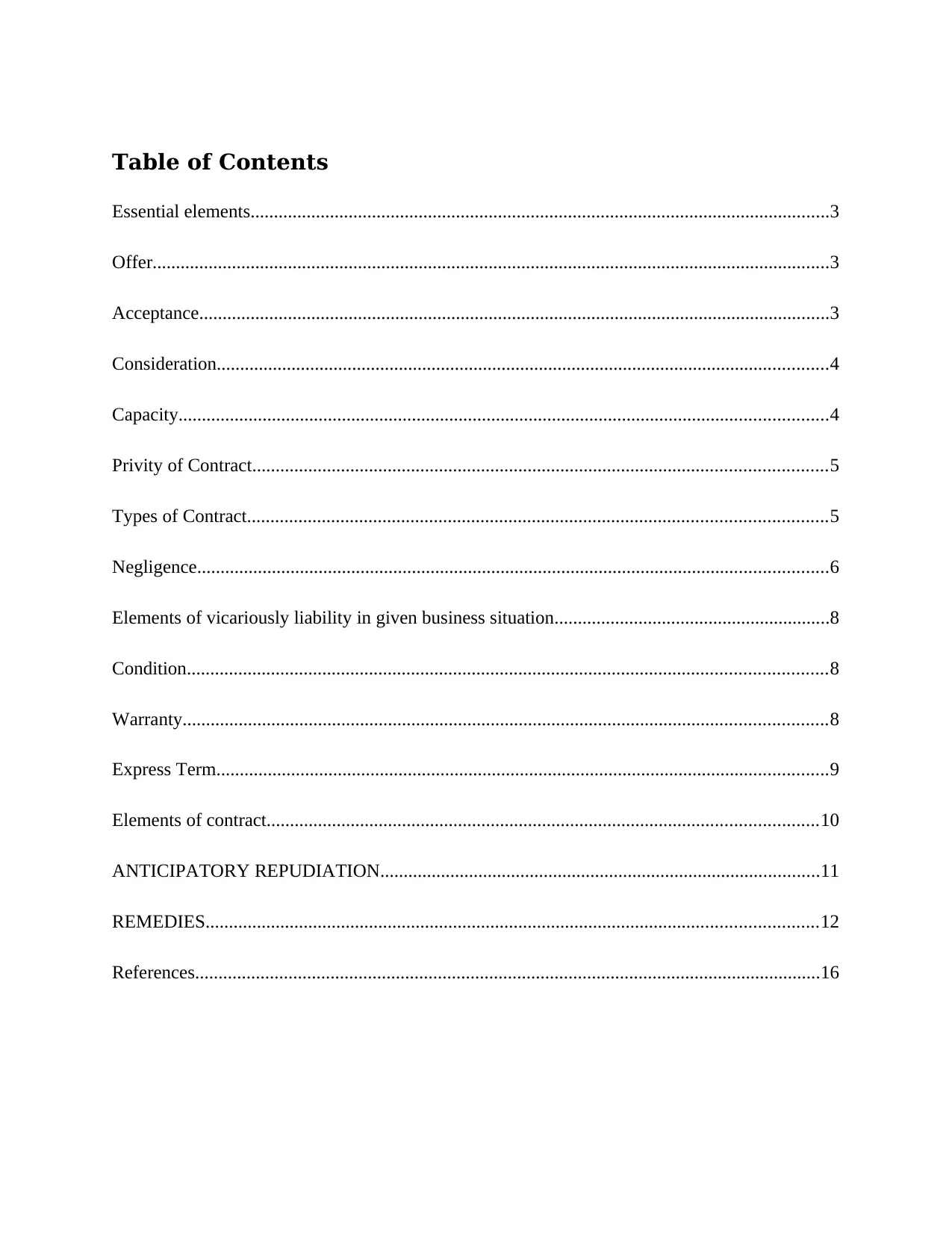
Table of Contents
Essential elements............................................................................................................................3
Offer.................................................................................................................................................3
Acceptance.......................................................................................................................................3
Consideration...................................................................................................................................4
Capacity...........................................................................................................................................4
Privity of Contract...........................................................................................................................5
Types of Contract............................................................................................................................5
Negligence.......................................................................................................................................6
Elements of vicariously liability in given business situation...........................................................8
Condition.........................................................................................................................................8
Warranty..........................................................................................................................................8
Express Term...................................................................................................................................9
Elements of contract......................................................................................................................10
ANTICIPATORY REPUDIATION..............................................................................................11
REMEDIES...................................................................................................................................12
References......................................................................................................................................16
Essential elements............................................................................................................................3
Offer.................................................................................................................................................3
Acceptance.......................................................................................................................................3
Consideration...................................................................................................................................4
Capacity...........................................................................................................................................4
Privity of Contract...........................................................................................................................5
Types of Contract............................................................................................................................5
Negligence.......................................................................................................................................6
Elements of vicariously liability in given business situation...........................................................8
Condition.........................................................................................................................................8
Warranty..........................................................................................................................................8
Express Term...................................................................................................................................9
Elements of contract......................................................................................................................10
ANTICIPATORY REPUDIATION..............................................................................................11
REMEDIES...................................................................................................................................12
References......................................................................................................................................16
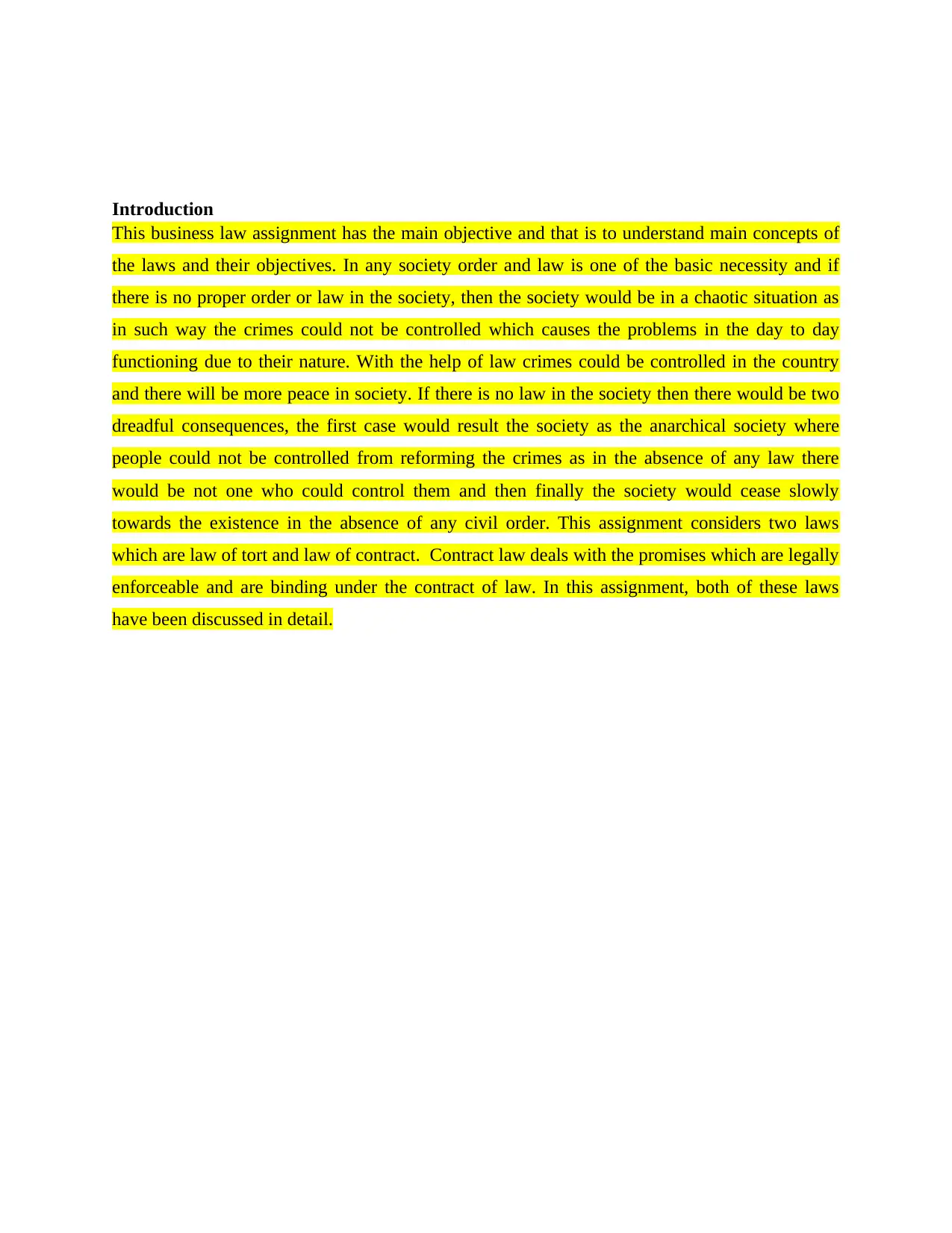
Introduction
This business law assignment has the main objective and that is to understand main concepts of
the laws and their objectives. In any society order and law is one of the basic necessity and if
there is no proper order or law in the society, then the society would be in a chaotic situation as
in such way the crimes could not be controlled which causes the problems in the day to day
functioning due to their nature. With the help of law crimes could be controlled in the country
and there will be more peace in society. If there is no law in the society then there would be two
dreadful consequences, the first case would result the society as the anarchical society where
people could not be controlled from reforming the crimes as in the absence of any law there
would be not one who could control them and then finally the society would cease slowly
towards the existence in the absence of any civil order. This assignment considers two laws
which are law of tort and law of contract. Contract law deals with the promises which are legally
enforceable and are binding under the contract of law. In this assignment, both of these laws
have been discussed in detail.
This business law assignment has the main objective and that is to understand main concepts of
the laws and their objectives. In any society order and law is one of the basic necessity and if
there is no proper order or law in the society, then the society would be in a chaotic situation as
in such way the crimes could not be controlled which causes the problems in the day to day
functioning due to their nature. With the help of law crimes could be controlled in the country
and there will be more peace in society. If there is no law in the society then there would be two
dreadful consequences, the first case would result the society as the anarchical society where
people could not be controlled from reforming the crimes as in the absence of any law there
would be not one who could control them and then finally the society would cease slowly
towards the existence in the absence of any civil order. This assignment considers two laws
which are law of tort and law of contract. Contract law deals with the promises which are legally
enforceable and are binding under the contract of law. In this assignment, both of these laws
have been discussed in detail.
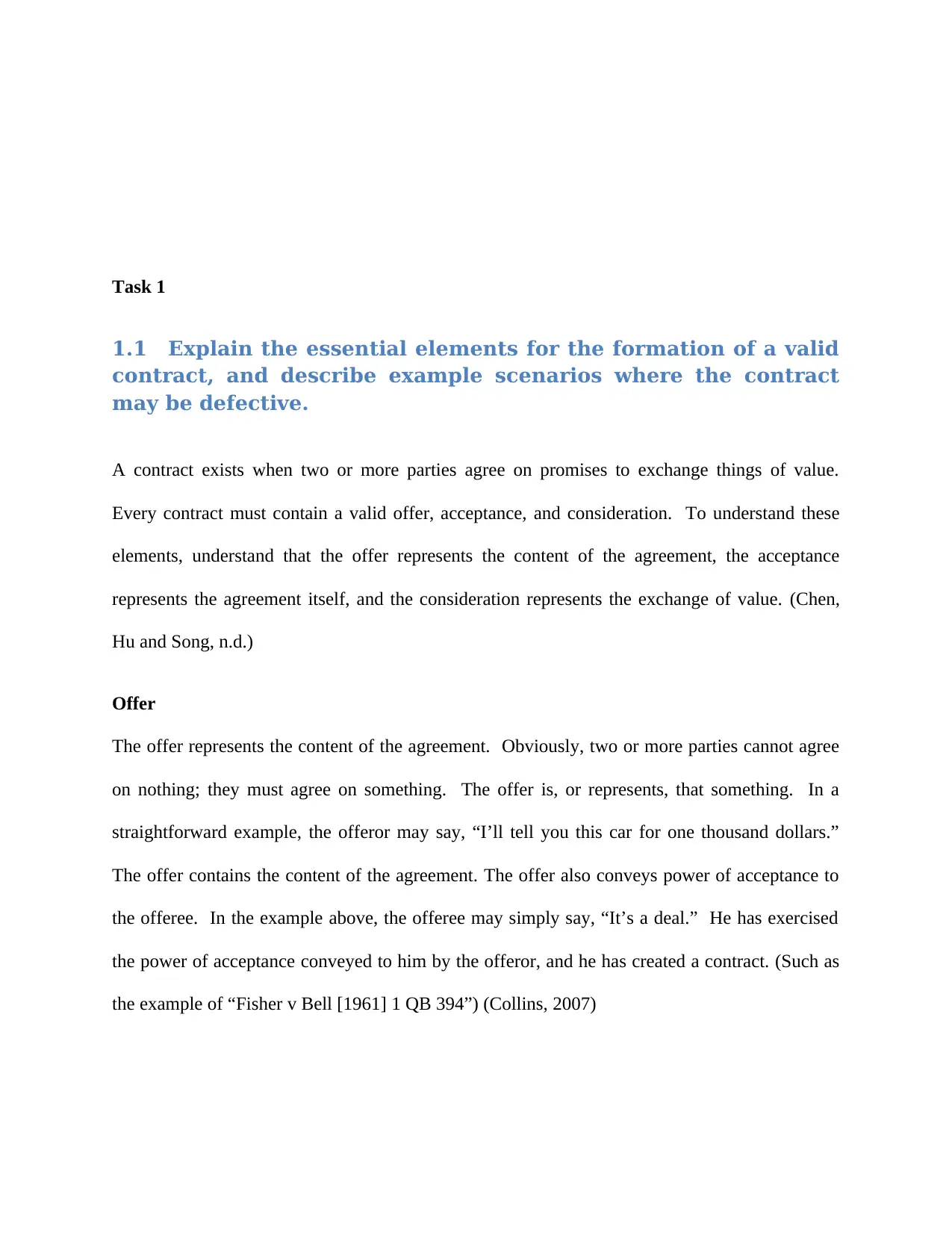
Task 1
1.1 Explain the essential elements for the formation of a valid
contract, and describe example scenarios where the contract
may be defective.
A contract exists when two or more parties agree on promises to exchange things of value.
Every contract must contain a valid offer, acceptance, and consideration. To understand these
elements, understand that the offer represents the content of the agreement, the acceptance
represents the agreement itself, and the consideration represents the exchange of value. (Chen,
Hu and Song, n.d.)
Offer
The offer represents the content of the agreement. Obviously, two or more parties cannot agree
on nothing; they must agree on something. The offer is, or represents, that something. In a
straightforward example, the offeror may say, “I’ll tell you this car for one thousand dollars.”
The offer contains the content of the agreement. The offer also conveys power of acceptance to
the offeree. In the example above, the offeree may simply say, “It’s a deal.” He has exercised
the power of acceptance conveyed to him by the offeror, and he has created a contract. (Such as
the example of “Fisher v Bell [1961] 1 QB 394”) (Collins, 2007)
1.1 Explain the essential elements for the formation of a valid
contract, and describe example scenarios where the contract
may be defective.
A contract exists when two or more parties agree on promises to exchange things of value.
Every contract must contain a valid offer, acceptance, and consideration. To understand these
elements, understand that the offer represents the content of the agreement, the acceptance
represents the agreement itself, and the consideration represents the exchange of value. (Chen,
Hu and Song, n.d.)
Offer
The offer represents the content of the agreement. Obviously, two or more parties cannot agree
on nothing; they must agree on something. The offer is, or represents, that something. In a
straightforward example, the offeror may say, “I’ll tell you this car for one thousand dollars.”
The offer contains the content of the agreement. The offer also conveys power of acceptance to
the offeree. In the example above, the offeree may simply say, “It’s a deal.” He has exercised
the power of acceptance conveyed to him by the offeror, and he has created a contract. (Such as
the example of “Fisher v Bell [1961] 1 QB 394”) (Collins, 2007)
Secure Best Marks with AI Grader
Need help grading? Try our AI Grader for instant feedback on your assignments.
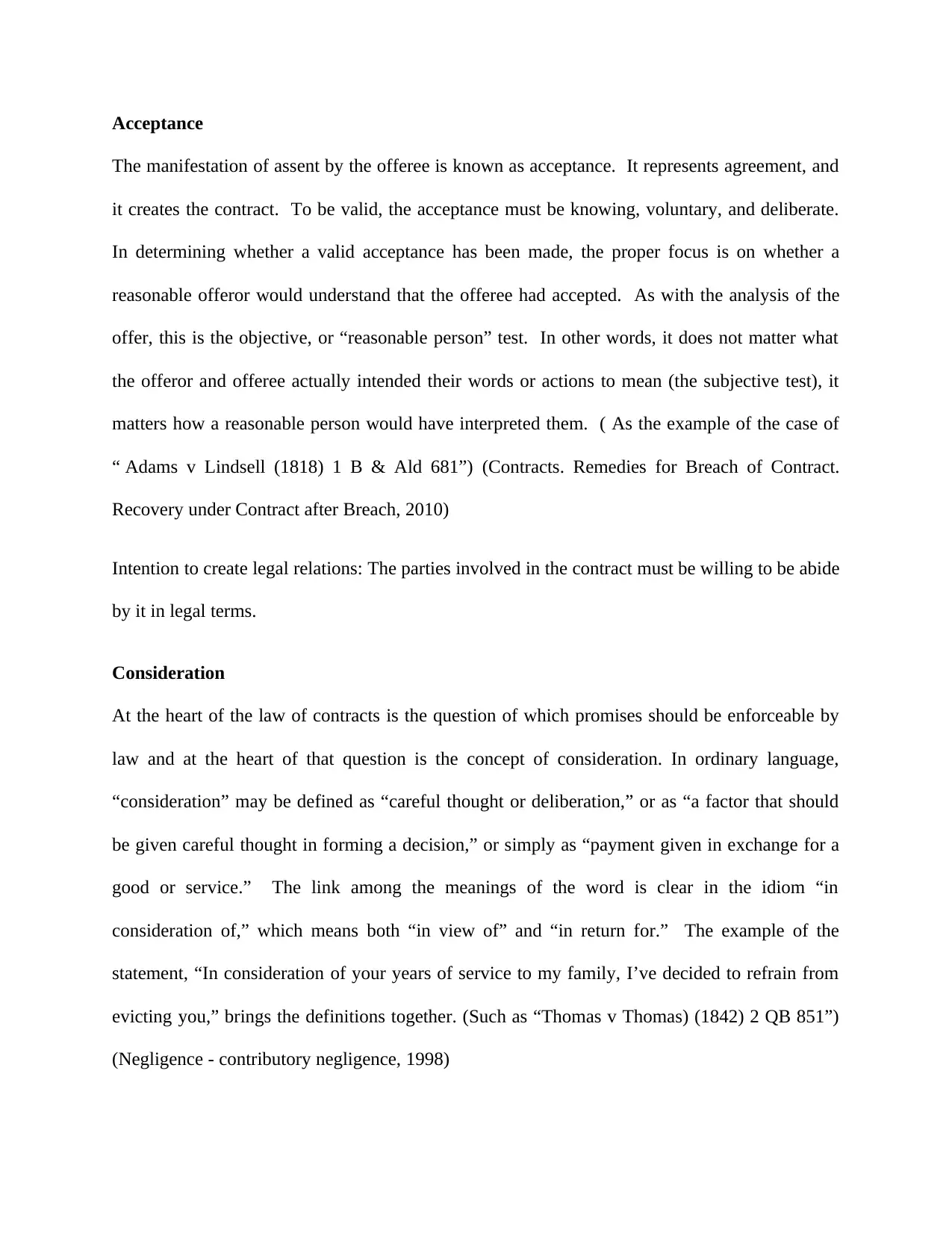
Acceptance
The manifestation of assent by the offeree is known as acceptance. It represents agreement, and
it creates the contract. To be valid, the acceptance must be knowing, voluntary, and deliberate.
In determining whether a valid acceptance has been made, the proper focus is on whether a
reasonable offeror would understand that the offeree had accepted. As with the analysis of the
offer, this is the objective, or “reasonable person” test. In other words, it does not matter what
the offeror and offeree actually intended their words or actions to mean (the subjective test), it
matters how a reasonable person would have interpreted them. ( As the example of the case of
“ Adams v Lindsell (1818) 1 B & Ald 681”) (Contracts. Remedies for Breach of Contract.
Recovery under Contract after Breach, 2010)
Intention to create legal relations: The parties involved in the contract must be willing to be abide
by it in legal terms.
Consideration
At the heart of the law of contracts is the question of which promises should be enforceable by
law and at the heart of that question is the concept of consideration. In ordinary language,
“consideration” may be defined as “careful thought or deliberation,” or as “a factor that should
be given careful thought in forming a decision,” or simply as “payment given in exchange for a
good or service.” The link among the meanings of the word is clear in the idiom “in
consideration of,” which means both “in view of” and “in return for.” The example of the
statement, “In consideration of your years of service to my family, I’ve decided to refrain from
evicting you,” brings the definitions together. (Such as “Thomas v Thomas) (1842) 2 QB 851”)
(Negligence - contributory negligence, 1998)
The manifestation of assent by the offeree is known as acceptance. It represents agreement, and
it creates the contract. To be valid, the acceptance must be knowing, voluntary, and deliberate.
In determining whether a valid acceptance has been made, the proper focus is on whether a
reasonable offeror would understand that the offeree had accepted. As with the analysis of the
offer, this is the objective, or “reasonable person” test. In other words, it does not matter what
the offeror and offeree actually intended their words or actions to mean (the subjective test), it
matters how a reasonable person would have interpreted them. ( As the example of the case of
“ Adams v Lindsell (1818) 1 B & Ald 681”) (Contracts. Remedies for Breach of Contract.
Recovery under Contract after Breach, 2010)
Intention to create legal relations: The parties involved in the contract must be willing to be abide
by it in legal terms.
Consideration
At the heart of the law of contracts is the question of which promises should be enforceable by
law and at the heart of that question is the concept of consideration. In ordinary language,
“consideration” may be defined as “careful thought or deliberation,” or as “a factor that should
be given careful thought in forming a decision,” or simply as “payment given in exchange for a
good or service.” The link among the meanings of the word is clear in the idiom “in
consideration of,” which means both “in view of” and “in return for.” The example of the
statement, “In consideration of your years of service to my family, I’ve decided to refrain from
evicting you,” brings the definitions together. (Such as “Thomas v Thomas) (1842) 2 QB 851”)
(Negligence - contributory negligence, 1998)
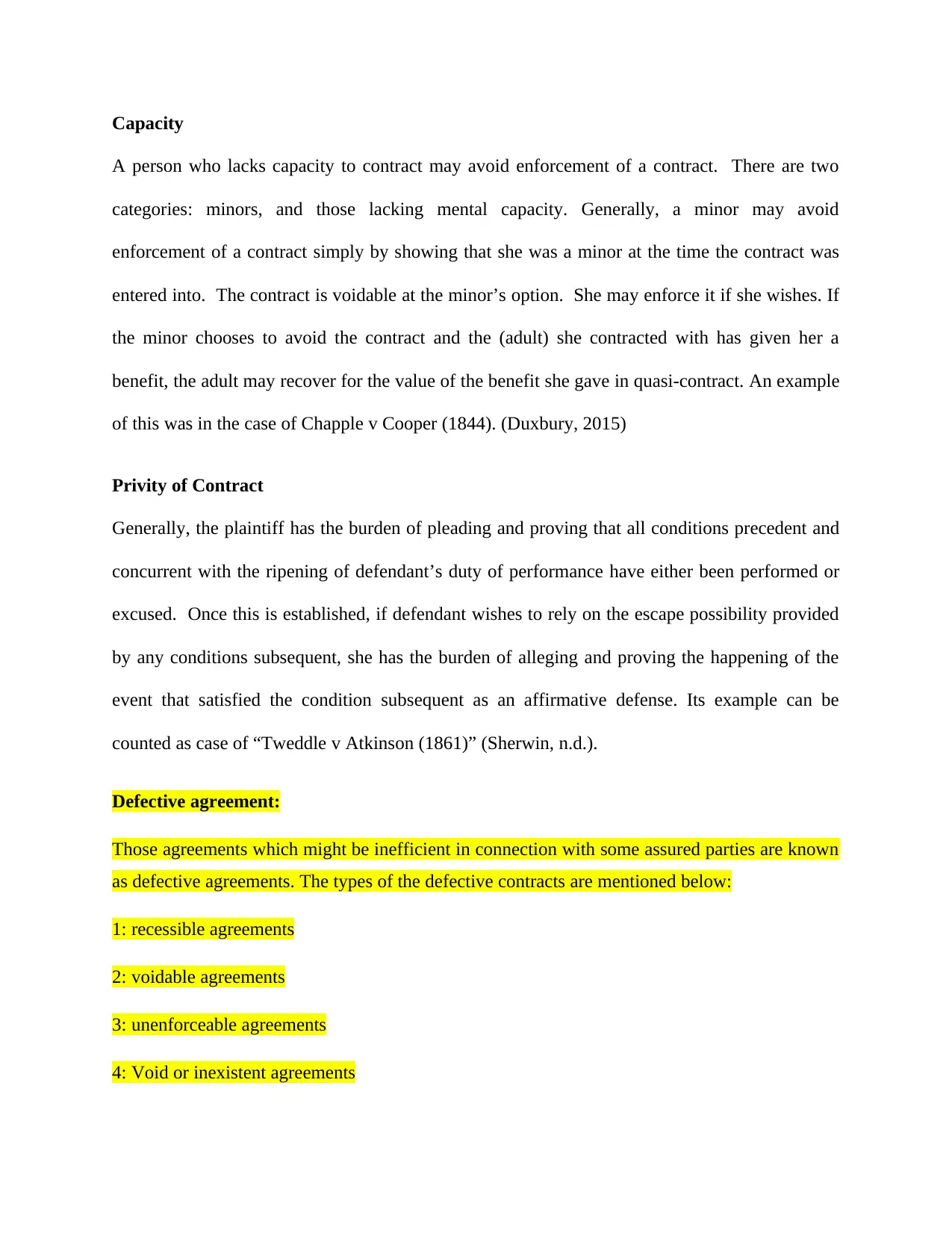
Capacity
A person who lacks capacity to contract may avoid enforcement of a contract. There are two
categories: minors, and those lacking mental capacity. Generally, a minor may avoid
enforcement of a contract simply by showing that she was a minor at the time the contract was
entered into. The contract is voidable at the minor’s option. She may enforce it if she wishes. If
the minor chooses to avoid the contract and the (adult) she contracted with has given her a
benefit, the adult may recover for the value of the benefit she gave in quasi-contract. An example
of this was in the case of Chapple v Cooper (1844). (Duxbury, 2015)
Privity of Contract
Generally, the plaintiff has the burden of pleading and proving that all conditions precedent and
concurrent with the ripening of defendant’s duty of performance have either been performed or
excused. Once this is established, if defendant wishes to rely on the escape possibility provided
by any conditions subsequent, she has the burden of alleging and proving the happening of the
event that satisfied the condition subsequent as an affirmative defense. Its example can be
counted as case of “Tweddle v Atkinson (1861)” (Sherwin, n.d.).
Defective agreement:
Those agreements which might be inefficient in connection with some assured parties are known
as defective agreements. The types of the defective contracts are mentioned below:
1: recessible agreements
2: voidable agreements
3: unenforceable agreements
4: Void or inexistent agreements
A person who lacks capacity to contract may avoid enforcement of a contract. There are two
categories: minors, and those lacking mental capacity. Generally, a minor may avoid
enforcement of a contract simply by showing that she was a minor at the time the contract was
entered into. The contract is voidable at the minor’s option. She may enforce it if she wishes. If
the minor chooses to avoid the contract and the (adult) she contracted with has given her a
benefit, the adult may recover for the value of the benefit she gave in quasi-contract. An example
of this was in the case of Chapple v Cooper (1844). (Duxbury, 2015)
Privity of Contract
Generally, the plaintiff has the burden of pleading and proving that all conditions precedent and
concurrent with the ripening of defendant’s duty of performance have either been performed or
excused. Once this is established, if defendant wishes to rely on the escape possibility provided
by any conditions subsequent, she has the burden of alleging and proving the happening of the
event that satisfied the condition subsequent as an affirmative defense. Its example can be
counted as case of “Tweddle v Atkinson (1861)” (Sherwin, n.d.).
Defective agreement:
Those agreements which might be inefficient in connection with some assured parties are known
as defective agreements. The types of the defective contracts are mentioned below:
1: recessible agreements
2: voidable agreements
3: unenforceable agreements
4: Void or inexistent agreements
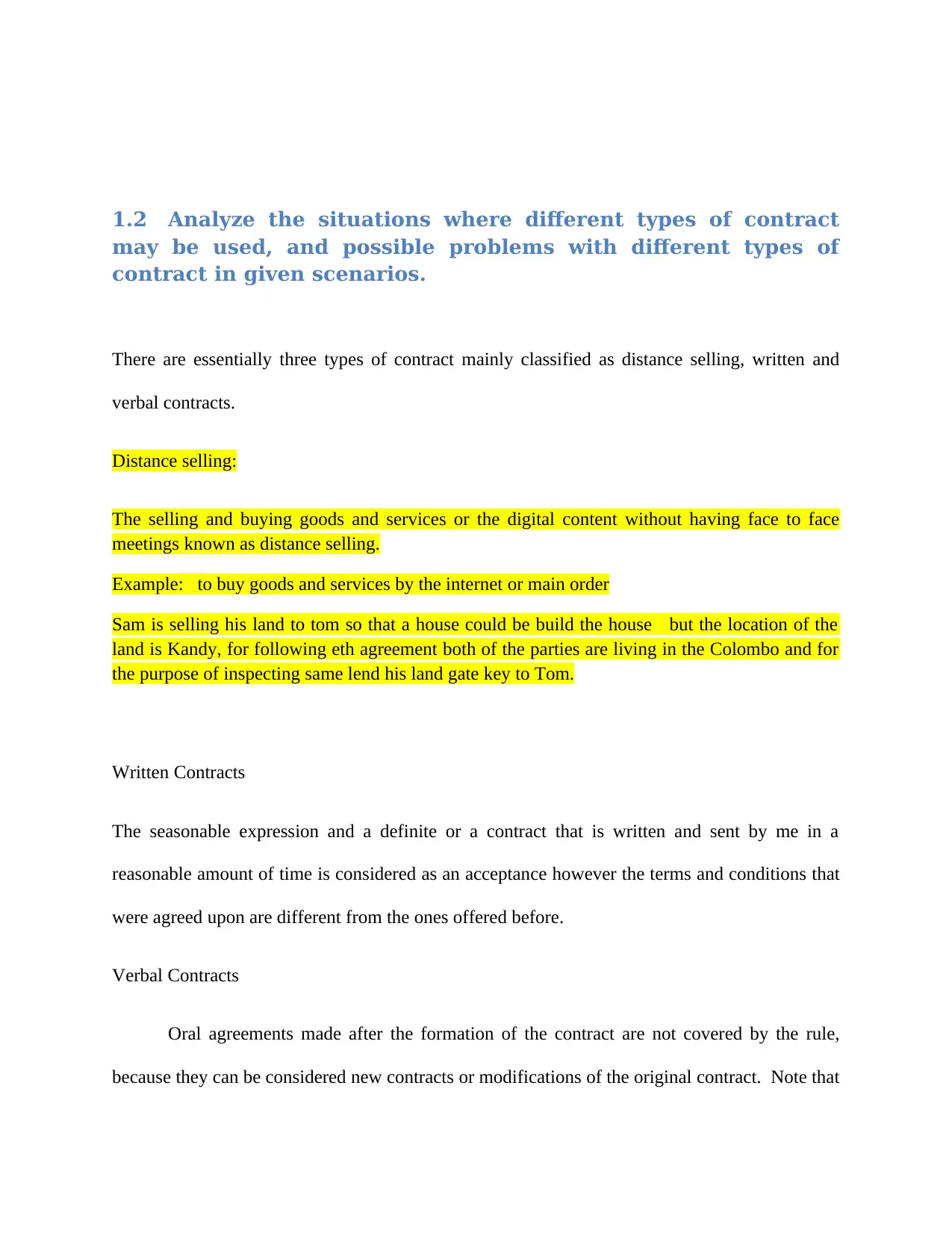
1.2 Analyze the situations where different types of contract
may be used, and possible problems with different types of
contract in given scenarios.
There are essentially three types of contract mainly classified as distance selling, written and
verbal contracts.
Distance selling:
The selling and buying goods and services or the digital content without having face to face
meetings known as distance selling.
Example: to buy goods and services by the internet or main order
Sam is selling his land to tom so that a house could be build the house but the location of the
land is Kandy, for following eth agreement both of the parties are living in the Colombo and for
the purpose of inspecting same lend his land gate key to Tom.
Written Contracts
The seasonable expression and a definite or a contract that is written and sent by me in a
reasonable amount of time is considered as an acceptance however the terms and conditions that
were agreed upon are different from the ones offered before.
Verbal Contracts
Oral agreements made after the formation of the contract are not covered by the rule,
because they can be considered new contracts or modifications of the original contract. Note that
may be used, and possible problems with different types of
contract in given scenarios.
There are essentially three types of contract mainly classified as distance selling, written and
verbal contracts.
Distance selling:
The selling and buying goods and services or the digital content without having face to face
meetings known as distance selling.
Example: to buy goods and services by the internet or main order
Sam is selling his land to tom so that a house could be build the house but the location of the
land is Kandy, for following eth agreement both of the parties are living in the Colombo and for
the purpose of inspecting same lend his land gate key to Tom.
Written Contracts
The seasonable expression and a definite or a contract that is written and sent by me in a
reasonable amount of time is considered as an acceptance however the terms and conditions that
were agreed upon are different from the ones offered before.
Verbal Contracts
Oral agreements made after the formation of the contract are not covered by the rule,
because they can be considered new contracts or modifications of the original contract. Note that
Paraphrase This Document
Need a fresh take? Get an instant paraphrase of this document with our AI Paraphraser
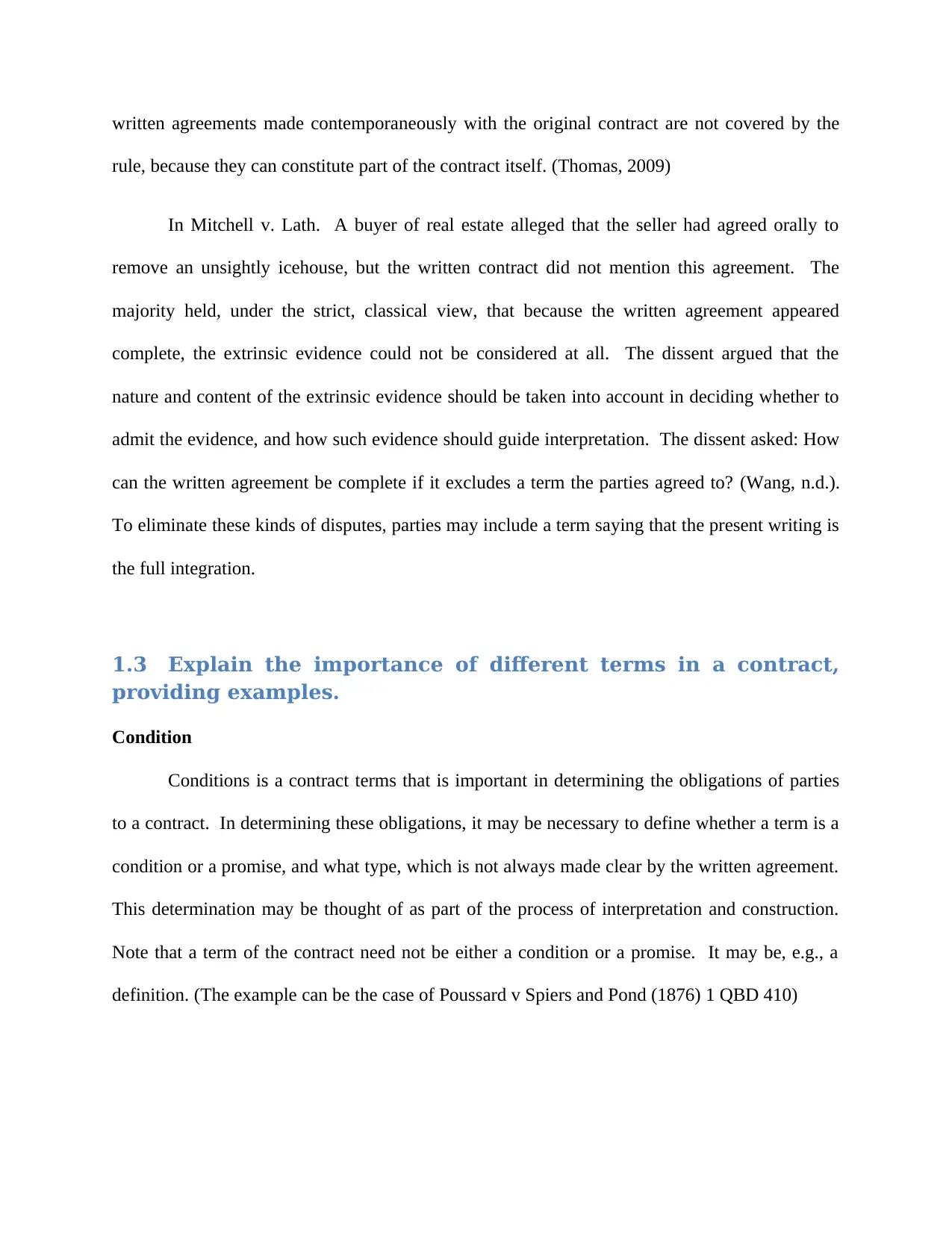
written agreements made contemporaneously with the original contract are not covered by the
rule, because they can constitute part of the contract itself. (Thomas, 2009)
In Mitchell v. Lath. A buyer of real estate alleged that the seller had agreed orally to
remove an unsightly icehouse, but the written contract did not mention this agreement. The
majority held, under the strict, classical view, that because the written agreement appeared
complete, the extrinsic evidence could not be considered at all. The dissent argued that the
nature and content of the extrinsic evidence should be taken into account in deciding whether to
admit the evidence, and how such evidence should guide interpretation. The dissent asked: How
can the written agreement be complete if it excludes a term the parties agreed to? (Wang, n.d.).
To eliminate these kinds of disputes, parties may include a term saying that the present writing is
the full integration.
1.3 Explain the importance of different terms in a contract,
providing examples.
Condition
Conditions is a contract terms that is important in determining the obligations of parties
to a contract. In determining these obligations, it may be necessary to define whether a term is a
condition or a promise, and what type, which is not always made clear by the written agreement.
This determination may be thought of as part of the process of interpretation and construction.
Note that a term of the contract need not be either a condition or a promise. It may be, e.g., a
definition. (The example can be the case of Poussard v Spiers and Pond (1876) 1 QBD 410)
rule, because they can constitute part of the contract itself. (Thomas, 2009)
In Mitchell v. Lath. A buyer of real estate alleged that the seller had agreed orally to
remove an unsightly icehouse, but the written contract did not mention this agreement. The
majority held, under the strict, classical view, that because the written agreement appeared
complete, the extrinsic evidence could not be considered at all. The dissent argued that the
nature and content of the extrinsic evidence should be taken into account in deciding whether to
admit the evidence, and how such evidence should guide interpretation. The dissent asked: How
can the written agreement be complete if it excludes a term the parties agreed to? (Wang, n.d.).
To eliminate these kinds of disputes, parties may include a term saying that the present writing is
the full integration.
1.3 Explain the importance of different terms in a contract,
providing examples.
Condition
Conditions is a contract terms that is important in determining the obligations of parties
to a contract. In determining these obligations, it may be necessary to define whether a term is a
condition or a promise, and what type, which is not always made clear by the written agreement.
This determination may be thought of as part of the process of interpretation and construction.
Note that a term of the contract need not be either a condition or a promise. It may be, e.g., a
definition. (The example can be the case of Poussard v Spiers and Pond (1876) 1 QBD 410)
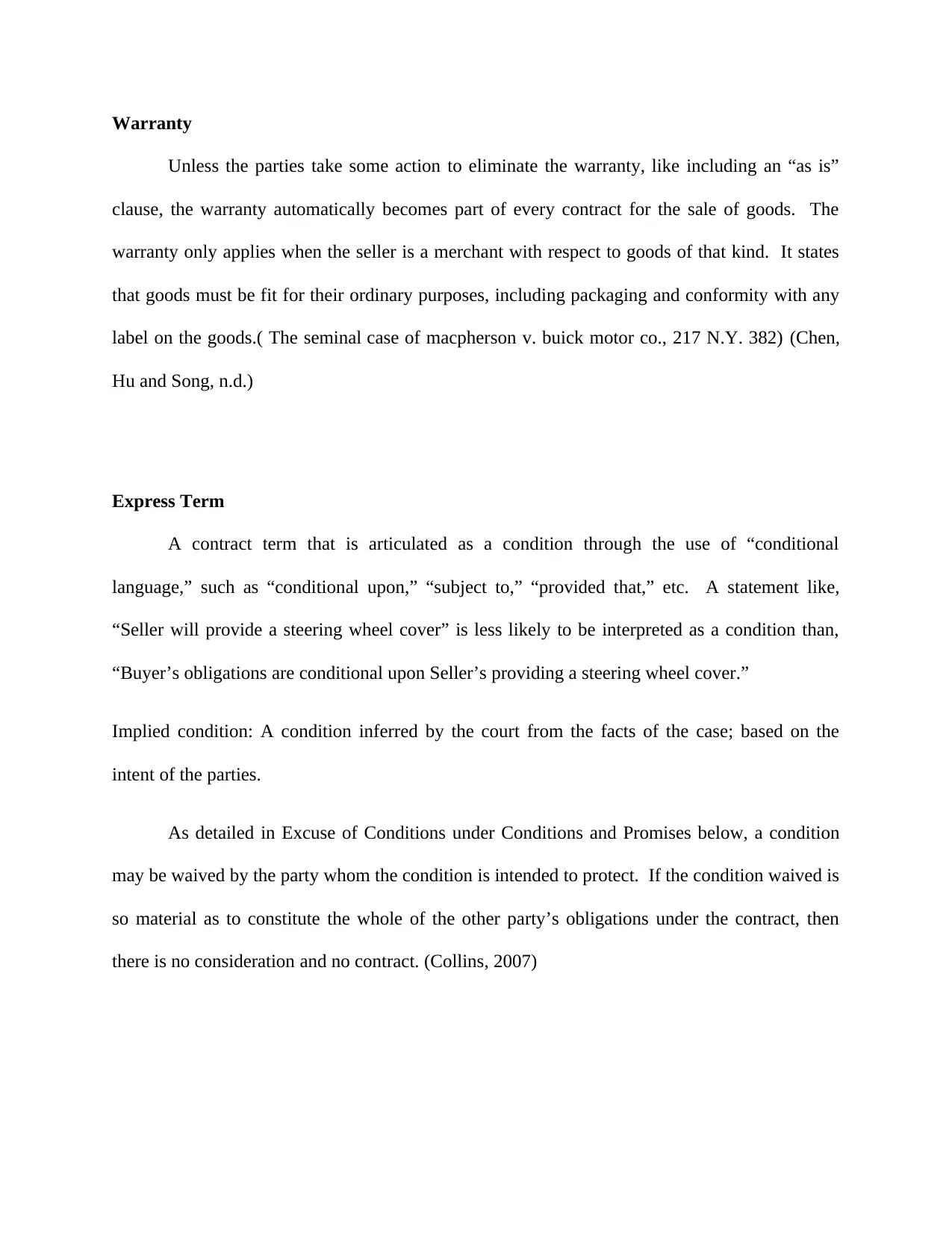
Warranty
Unless the parties take some action to eliminate the warranty, like including an “as is”
clause, the warranty automatically becomes part of every contract for the sale of goods. The
warranty only applies when the seller is a merchant with respect to goods of that kind. It states
that goods must be fit for their ordinary purposes, including packaging and conformity with any
label on the goods.( The seminal case of macpherson v. buick motor co., 217 N.Y. 382) (Chen,
Hu and Song, n.d.)
Express Term
A contract term that is articulated as a condition through the use of “conditional
language,” such as “conditional upon,” “subject to,” “provided that,” etc. A statement like,
“Seller will provide a steering wheel cover” is less likely to be interpreted as a condition than,
“Buyer’s obligations are conditional upon Seller’s providing a steering wheel cover.”
Implied condition: A condition inferred by the court from the facts of the case; based on the
intent of the parties.
As detailed in Excuse of Conditions under Conditions and Promises below, a condition
may be waived by the party whom the condition is intended to protect. If the condition waived is
so material as to constitute the whole of the other party’s obligations under the contract, then
there is no consideration and no contract. (Collins, 2007)
Unless the parties take some action to eliminate the warranty, like including an “as is”
clause, the warranty automatically becomes part of every contract for the sale of goods. The
warranty only applies when the seller is a merchant with respect to goods of that kind. It states
that goods must be fit for their ordinary purposes, including packaging and conformity with any
label on the goods.( The seminal case of macpherson v. buick motor co., 217 N.Y. 382) (Chen,
Hu and Song, n.d.)
Express Term
A contract term that is articulated as a condition through the use of “conditional
language,” such as “conditional upon,” “subject to,” “provided that,” etc. A statement like,
“Seller will provide a steering wheel cover” is less likely to be interpreted as a condition than,
“Buyer’s obligations are conditional upon Seller’s providing a steering wheel cover.”
Implied condition: A condition inferred by the court from the facts of the case; based on the
intent of the parties.
As detailed in Excuse of Conditions under Conditions and Promises below, a condition
may be waived by the party whom the condition is intended to protect. If the condition waived is
so material as to constitute the whole of the other party’s obligations under the contract, then
there is no consideration and no contract. (Collins, 2007)
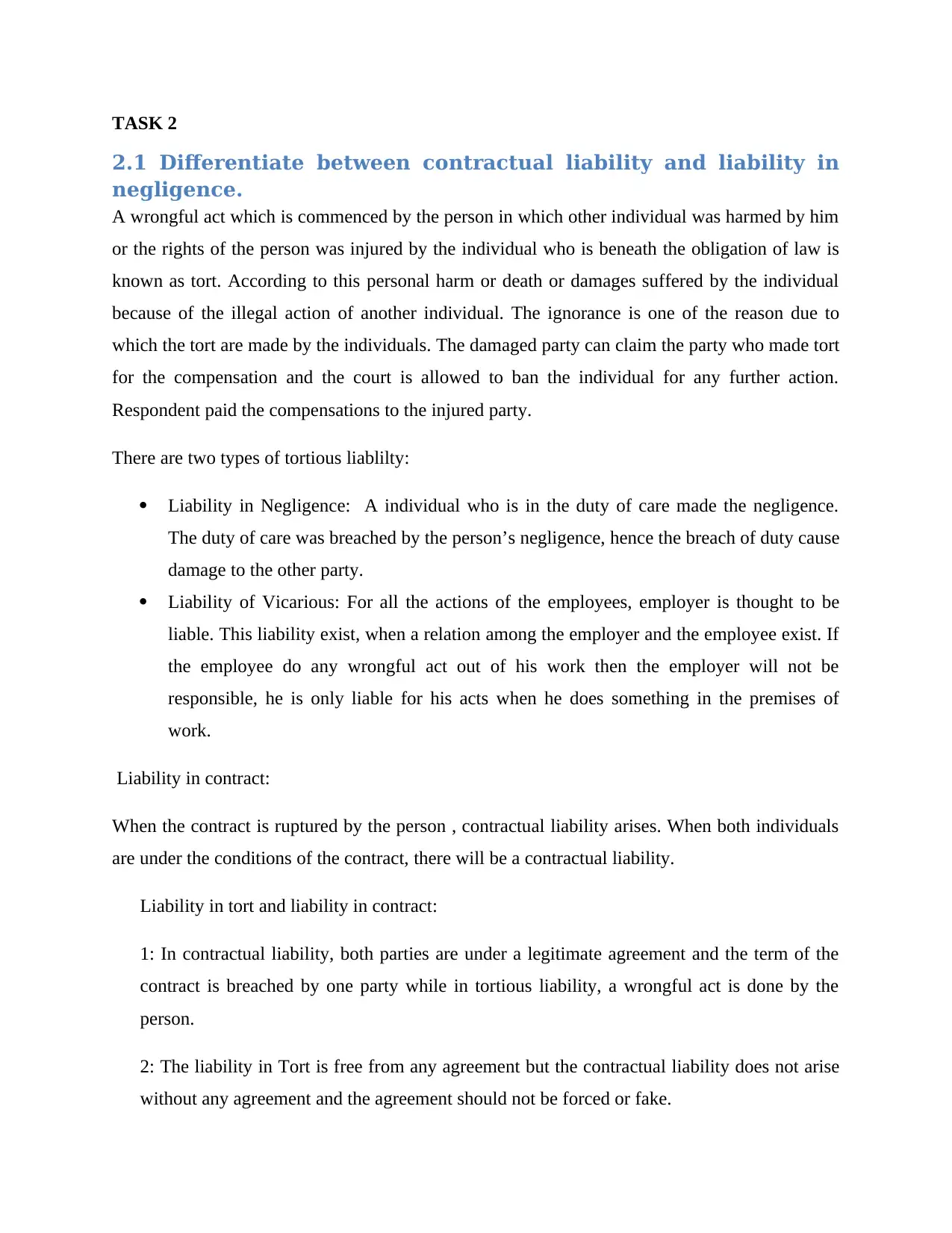
TASK 2
2.1 Differentiate between contractual liability and liability in
negligence.
A wrongful act which is commenced by the person in which other individual was harmed by him
or the rights of the person was injured by the individual who is beneath the obligation of law is
known as tort. According to this personal harm or death or damages suffered by the individual
because of the illegal action of another individual. The ignorance is one of the reason due to
which the tort are made by the individuals. The damaged party can claim the party who made tort
for the compensation and the court is allowed to ban the individual for any further action.
Respondent paid the compensations to the injured party.
There are two types of tortious liablilty:
Liability in Negligence: A individual who is in the duty of care made the negligence.
The duty of care was breached by the person’s negligence, hence the breach of duty cause
damage to the other party.
Liability of Vicarious: For all the actions of the employees, employer is thought to be
liable. This liability exist, when a relation among the employer and the employee exist. If
the employee do any wrongful act out of his work then the employer will not be
responsible, he is only liable for his acts when he does something in the premises of
work.
Liability in contract:
When the contract is ruptured by the person , contractual liability arises. When both individuals
are under the conditions of the contract, there will be a contractual liability.
Liability in tort and liability in contract:
1: In contractual liability, both parties are under a legitimate agreement and the term of the
contract is breached by one party while in tortious liability, a wrongful act is done by the
person.
2: The liability in Tort is free from any agreement but the contractual liability does not arise
without any agreement and the agreement should not be forced or fake.
2.1 Differentiate between contractual liability and liability in
negligence.
A wrongful act which is commenced by the person in which other individual was harmed by him
or the rights of the person was injured by the individual who is beneath the obligation of law is
known as tort. According to this personal harm or death or damages suffered by the individual
because of the illegal action of another individual. The ignorance is one of the reason due to
which the tort are made by the individuals. The damaged party can claim the party who made tort
for the compensation and the court is allowed to ban the individual for any further action.
Respondent paid the compensations to the injured party.
There are two types of tortious liablilty:
Liability in Negligence: A individual who is in the duty of care made the negligence.
The duty of care was breached by the person’s negligence, hence the breach of duty cause
damage to the other party.
Liability of Vicarious: For all the actions of the employees, employer is thought to be
liable. This liability exist, when a relation among the employer and the employee exist. If
the employee do any wrongful act out of his work then the employer will not be
responsible, he is only liable for his acts when he does something in the premises of
work.
Liability in contract:
When the contract is ruptured by the person , contractual liability arises. When both individuals
are under the conditions of the contract, there will be a contractual liability.
Liability in tort and liability in contract:
1: In contractual liability, both parties are under a legitimate agreement and the term of the
contract is breached by one party while in tortious liability, a wrongful act is done by the
person.
2: The liability in Tort is free from any agreement but the contractual liability does not arise
without any agreement and the agreement should not be forced or fake.
Secure Best Marks with AI Grader
Need help grading? Try our AI Grader for instant feedback on your assignments.
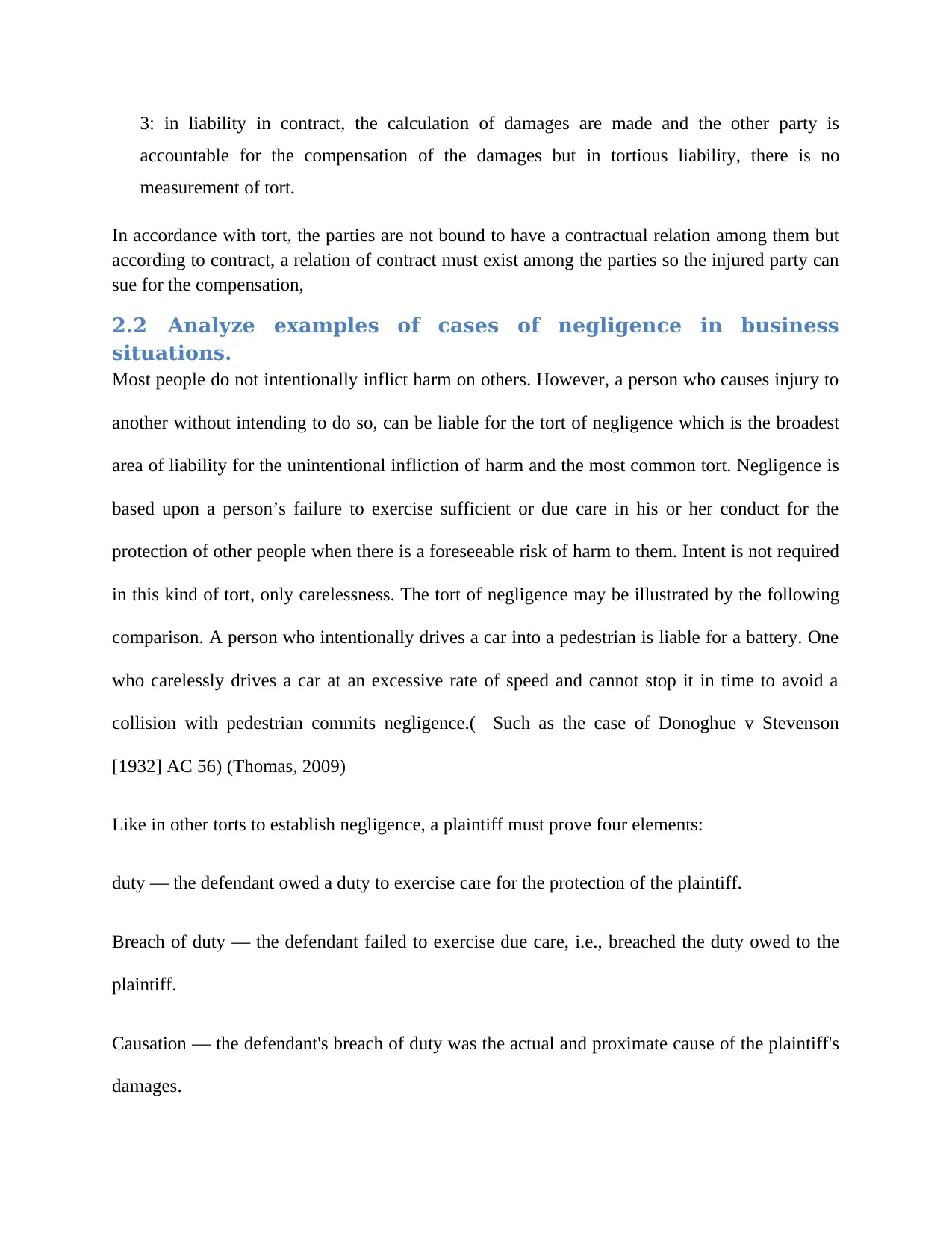
3: in liability in contract, the calculation of damages are made and the other party is
accountable for the compensation of the damages but in tortious liability, there is no
measurement of tort.
In accordance with tort, the parties are not bound to have a contractual relation among them but
according to contract, a relation of contract must exist among the parties so the injured party can
sue for the compensation,
2.2 Analyze examples of cases of negligence in business
situations.
Most people do not intentionally inflict harm on others. However, a person who causes injury to
another without intending to do so, can be liable for the tort of negligence which is the broadest
area of liability for the unintentional infliction of harm and the most common tort. Negligence is
based upon a person’s failure to exercise sufficient or due care in his or her conduct for the
protection of other people when there is a foreseeable risk of harm to them. Intent is not required
in this kind of tort, only carelessness. The tort of negligence may be illustrated by the following
comparison. A person who intentionally drives a car into a pedestrian is liable for a battery. One
who carelessly drives a car at an excessive rate of speed and cannot stop it in time to avoid a
collision with pedestrian commits negligence.( Such as the case of Donoghue v Stevenson
[1932] AC 56) (Thomas, 2009)
Like in other torts to establish negligence, a plaintiff must prove four elements:
duty — the defendant owed a duty to exercise care for the protection of the plaintiff.
Breach of duty — the defendant failed to exercise due care, i.e., breached the duty owed to the
plaintiff.
Causation — the defendant's breach of duty was the actual and proximate cause of the plaintiff's
damages.
accountable for the compensation of the damages but in tortious liability, there is no
measurement of tort.
In accordance with tort, the parties are not bound to have a contractual relation among them but
according to contract, a relation of contract must exist among the parties so the injured party can
sue for the compensation,
2.2 Analyze examples of cases of negligence in business
situations.
Most people do not intentionally inflict harm on others. However, a person who causes injury to
another without intending to do so, can be liable for the tort of negligence which is the broadest
area of liability for the unintentional infliction of harm and the most common tort. Negligence is
based upon a person’s failure to exercise sufficient or due care in his or her conduct for the
protection of other people when there is a foreseeable risk of harm to them. Intent is not required
in this kind of tort, only carelessness. The tort of negligence may be illustrated by the following
comparison. A person who intentionally drives a car into a pedestrian is liable for a battery. One
who carelessly drives a car at an excessive rate of speed and cannot stop it in time to avoid a
collision with pedestrian commits negligence.( Such as the case of Donoghue v Stevenson
[1932] AC 56) (Thomas, 2009)
Like in other torts to establish negligence, a plaintiff must prove four elements:
duty — the defendant owed a duty to exercise care for the protection of the plaintiff.
Breach of duty — the defendant failed to exercise due care, i.e., breached the duty owed to the
plaintiff.
Causation — the defendant's breach of duty was the actual and proximate cause of the plaintiff's
damages.
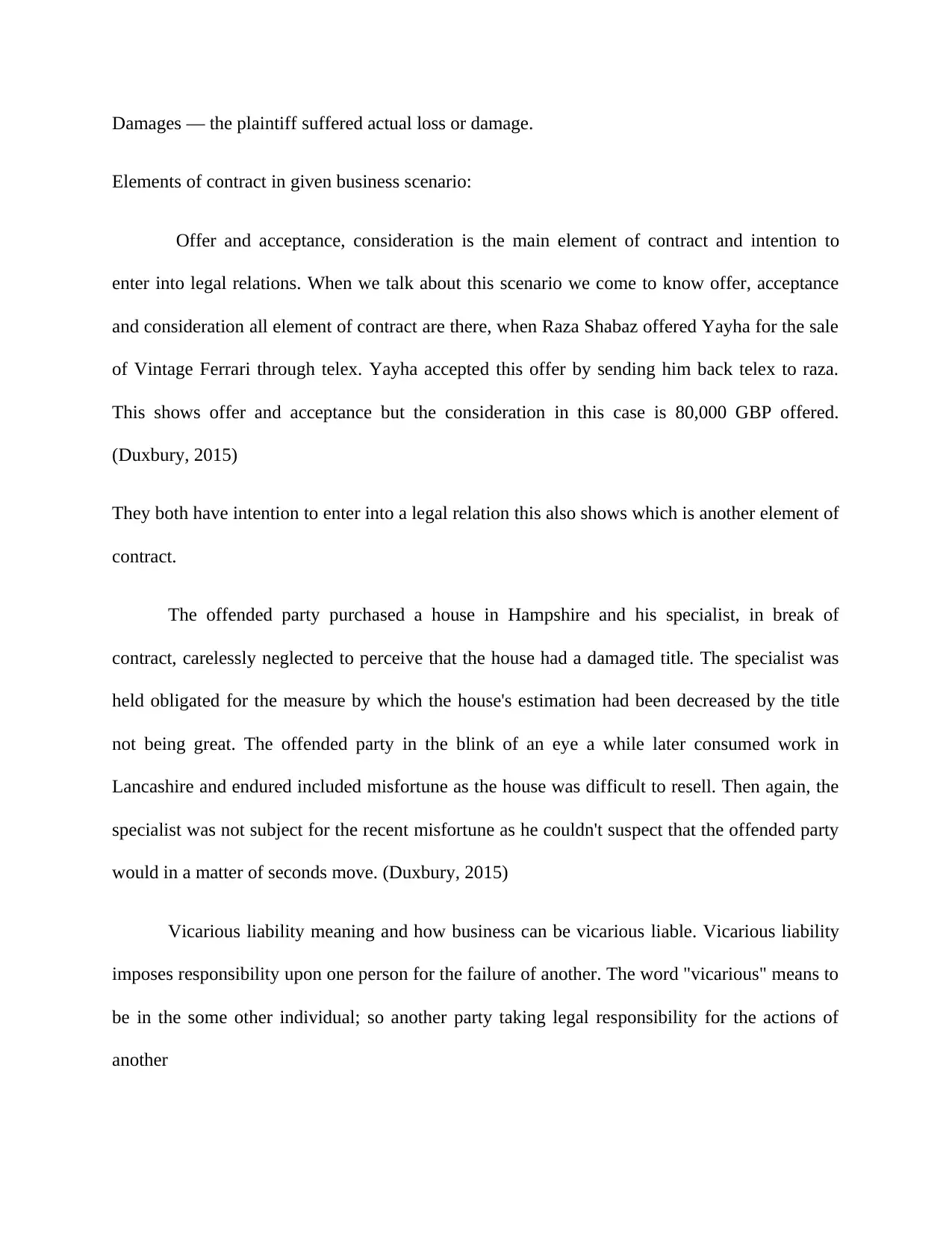
Damages — the plaintiff suffered actual loss or damage.
Elements of contract in given business scenario:
Offer and acceptance, consideration is the main element of contract and intention to
enter into legal relations. When we talk about this scenario we come to know offer, acceptance
and consideration all element of contract are there, when Raza Shabaz offered Yayha for the sale
of Vintage Ferrari through telex. Yayha accepted this offer by sending him back telex to raza.
This shows offer and acceptance but the consideration in this case is 80,000 GBP offered.
(Duxbury, 2015)
They both have intention to enter into a legal relation this also shows which is another element of
contract.
The offended party purchased a house in Hampshire and his specialist, in break of
contract, carelessly neglected to perceive that the house had a damaged title. The specialist was
held obligated for the measure by which the house's estimation had been decreased by the title
not being great. The offended party in the blink of an eye a while later consumed work in
Lancashire and endured included misfortune as the house was difficult to resell. Then again, the
specialist was not subject for the recent misfortune as he couldn't suspect that the offended party
would in a matter of seconds move. (Duxbury, 2015)
Vicarious liability meaning and how business can be vicarious liable. Vicarious liability
imposes responsibility upon one person for the failure of another. The word "vicarious" means to
be in the some other individual; so another party taking legal responsibility for the actions of
another
Elements of contract in given business scenario:
Offer and acceptance, consideration is the main element of contract and intention to
enter into legal relations. When we talk about this scenario we come to know offer, acceptance
and consideration all element of contract are there, when Raza Shabaz offered Yayha for the sale
of Vintage Ferrari through telex. Yayha accepted this offer by sending him back telex to raza.
This shows offer and acceptance but the consideration in this case is 80,000 GBP offered.
(Duxbury, 2015)
They both have intention to enter into a legal relation this also shows which is another element of
contract.
The offended party purchased a house in Hampshire and his specialist, in break of
contract, carelessly neglected to perceive that the house had a damaged title. The specialist was
held obligated for the measure by which the house's estimation had been decreased by the title
not being great. The offended party in the blink of an eye a while later consumed work in
Lancashire and endured included misfortune as the house was difficult to resell. Then again, the
specialist was not subject for the recent misfortune as he couldn't suspect that the offended party
would in a matter of seconds move. (Duxbury, 2015)
Vicarious liability meaning and how business can be vicarious liable. Vicarious liability
imposes responsibility upon one person for the failure of another. The word "vicarious" means to
be in the some other individual; so another party taking legal responsibility for the actions of
another
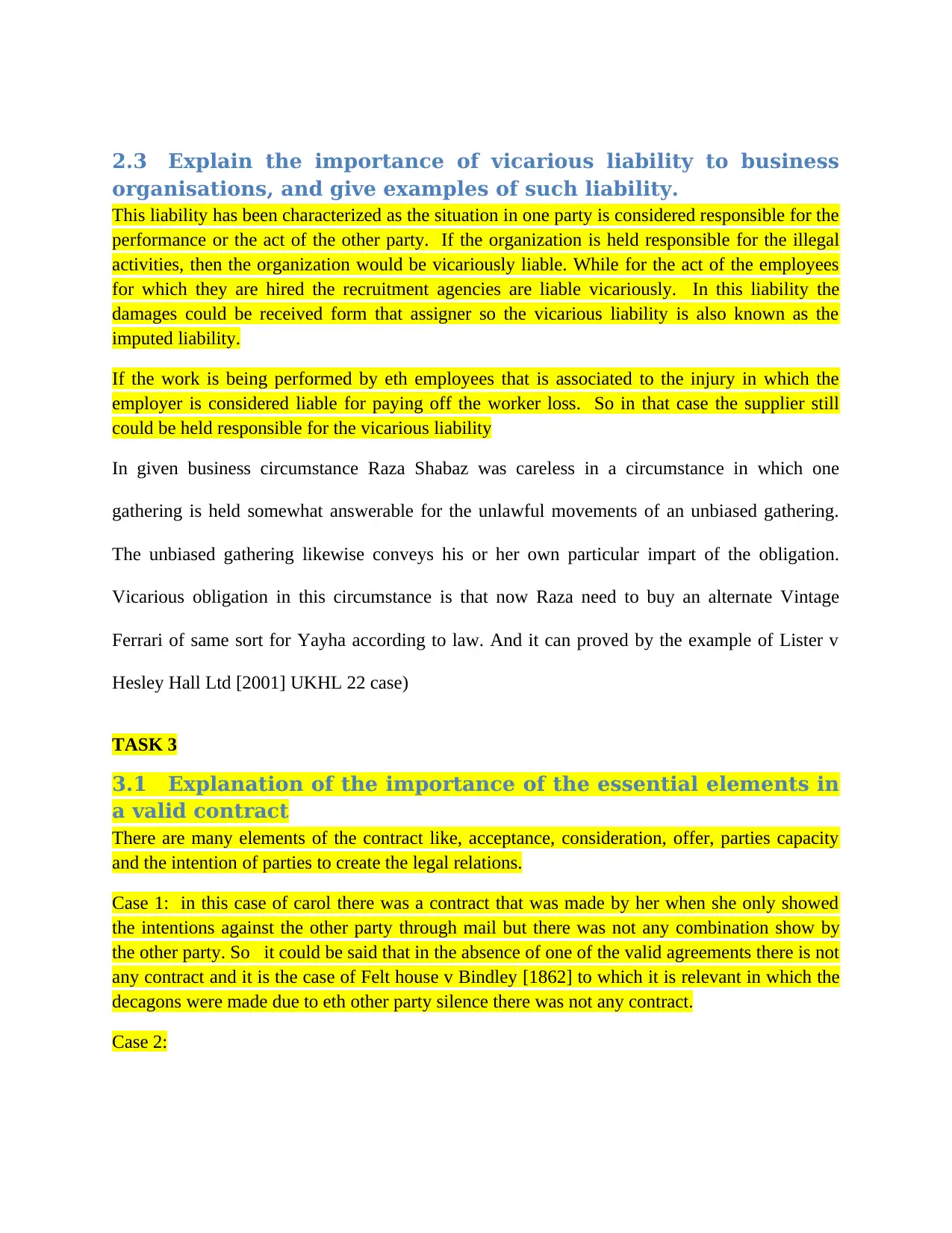
2.3 Explain the importance of vicarious liability to business
organisations, and give examples of such liability.
This liability has been characterized as the situation in one party is considered responsible for the
performance or the act of the other party. If the organization is held responsible for the illegal
activities, then the organization would be vicariously liable. While for the act of the employees
for which they are hired the recruitment agencies are liable vicariously. In this liability the
damages could be received form that assigner so the vicarious liability is also known as the
imputed liability.
If the work is being performed by eth employees that is associated to the injury in which the
employer is considered liable for paying off the worker loss. So in that case the supplier still
could be held responsible for the vicarious liability
In given business circumstance Raza Shabaz was careless in a circumstance in which one
gathering is held somewhat answerable for the unlawful movements of an unbiased gathering.
The unbiased gathering likewise conveys his or her own particular impart of the obligation.
Vicarious obligation in this circumstance is that now Raza need to buy an alternate Vintage
Ferrari of same sort for Yayha according to law. And it can proved by the example of Lister v
Hesley Hall Ltd [2001] UKHL 22 case)
TASK 3
3.1 Explanation of the importance of the essential elements in
a valid contract
There are many elements of the contract like, acceptance, consideration, offer, parties capacity
and the intention of parties to create the legal relations.
Case 1: in this case of carol there was a contract that was made by her when she only showed
the intentions against the other party through mail but there was not any combination show by
the other party. So it could be said that in the absence of one of the valid agreements there is not
any contract and it is the case of Felt house v Bindley [1862] to which it is relevant in which the
decagons were made due to eth other party silence there was not any contract.
Case 2:
organisations, and give examples of such liability.
This liability has been characterized as the situation in one party is considered responsible for the
performance or the act of the other party. If the organization is held responsible for the illegal
activities, then the organization would be vicariously liable. While for the act of the employees
for which they are hired the recruitment agencies are liable vicariously. In this liability the
damages could be received form that assigner so the vicarious liability is also known as the
imputed liability.
If the work is being performed by eth employees that is associated to the injury in which the
employer is considered liable for paying off the worker loss. So in that case the supplier still
could be held responsible for the vicarious liability
In given business circumstance Raza Shabaz was careless in a circumstance in which one
gathering is held somewhat answerable for the unlawful movements of an unbiased gathering.
The unbiased gathering likewise conveys his or her own particular impart of the obligation.
Vicarious obligation in this circumstance is that now Raza need to buy an alternate Vintage
Ferrari of same sort for Yayha according to law. And it can proved by the example of Lister v
Hesley Hall Ltd [2001] UKHL 22 case)
TASK 3
3.1 Explanation of the importance of the essential elements in
a valid contract
There are many elements of the contract like, acceptance, consideration, offer, parties capacity
and the intention of parties to create the legal relations.
Case 1: in this case of carol there was a contract that was made by her when she only showed
the intentions against the other party through mail but there was not any combination show by
the other party. So it could be said that in the absence of one of the valid agreements there is not
any contract and it is the case of Felt house v Bindley [1862] to which it is relevant in which the
decagons were made due to eth other party silence there was not any contract.
Case 2:
Paraphrase This Document
Need a fresh take? Get an instant paraphrase of this document with our AI Paraphraser
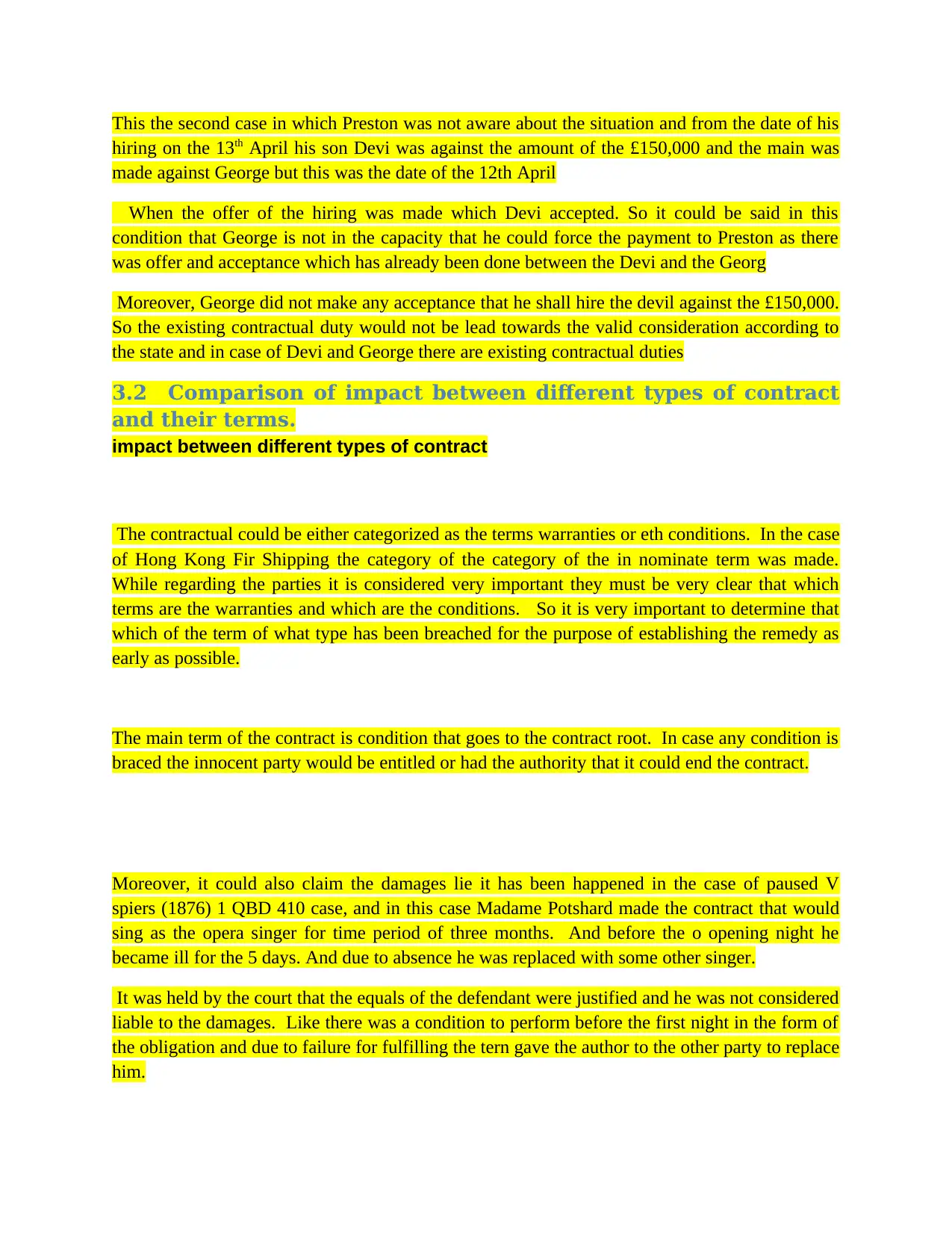
This the second case in which Preston was not aware about the situation and from the date of his
hiring on the 13th April his son Devi was against the amount of the £150,000 and the main was
made against George but this was the date of the 12th April
When the offer of the hiring was made which Devi accepted. So it could be said in this
condition that George is not in the capacity that he could force the payment to Preston as there
was offer and acceptance which has already been done between the Devi and the Georg
Moreover, George did not make any acceptance that he shall hire the devil against the £150,000.
So the existing contractual duty would not be lead towards the valid consideration according to
the state and in case of Devi and George there are existing contractual duties
3.2 Comparison of impact between different types of contract
and their terms.
impact between different types of contract
The contractual could be either categorized as the terms warranties or eth conditions. In the case
of Hong Kong Fir Shipping the category of the category of the in nominate term was made.
While regarding the parties it is considered very important they must be very clear that which
terms are the warranties and which are the conditions. So it is very important to determine that
which of the term of what type has been breached for the purpose of establishing the remedy as
early as possible.
The main term of the contract is condition that goes to the contract root. In case any condition is
braced the innocent party would be entitled or had the authority that it could end the contract.
Moreover, it could also claim the damages lie it has been happened in the case of paused V
spiers (1876) 1 QBD 410 case, and in this case Madame Potshard made the contract that would
sing as the opera singer for time period of three months. And before the o opening night he
became ill for the 5 days. And due to absence he was replaced with some other singer.
It was held by the court that the equals of the defendant were justified and he was not considered
liable to the damages. Like there was a condition to perform before the first night in the form of
the obligation and due to failure for fulfilling the tern gave the author to the other party to replace
him.
hiring on the 13th April his son Devi was against the amount of the £150,000 and the main was
made against George but this was the date of the 12th April
When the offer of the hiring was made which Devi accepted. So it could be said in this
condition that George is not in the capacity that he could force the payment to Preston as there
was offer and acceptance which has already been done between the Devi and the Georg
Moreover, George did not make any acceptance that he shall hire the devil against the £150,000.
So the existing contractual duty would not be lead towards the valid consideration according to
the state and in case of Devi and George there are existing contractual duties
3.2 Comparison of impact between different types of contract
and their terms.
impact between different types of contract
The contractual could be either categorized as the terms warranties or eth conditions. In the case
of Hong Kong Fir Shipping the category of the category of the in nominate term was made.
While regarding the parties it is considered very important they must be very clear that which
terms are the warranties and which are the conditions. So it is very important to determine that
which of the term of what type has been breached for the purpose of establishing the remedy as
early as possible.
The main term of the contract is condition that goes to the contract root. In case any condition is
braced the innocent party would be entitled or had the authority that it could end the contract.
Moreover, it could also claim the damages lie it has been happened in the case of paused V
spiers (1876) 1 QBD 410 case, and in this case Madame Potshard made the contract that would
sing as the opera singer for time period of three months. And before the o opening night he
became ill for the 5 days. And due to absence he was replaced with some other singer.
It was held by the court that the equals of the defendant were justified and he was not considered
liable to the damages. Like there was a condition to perform before the first night in the form of
the obligation and due to failure for fulfilling the tern gave the author to the other party to replace
him.
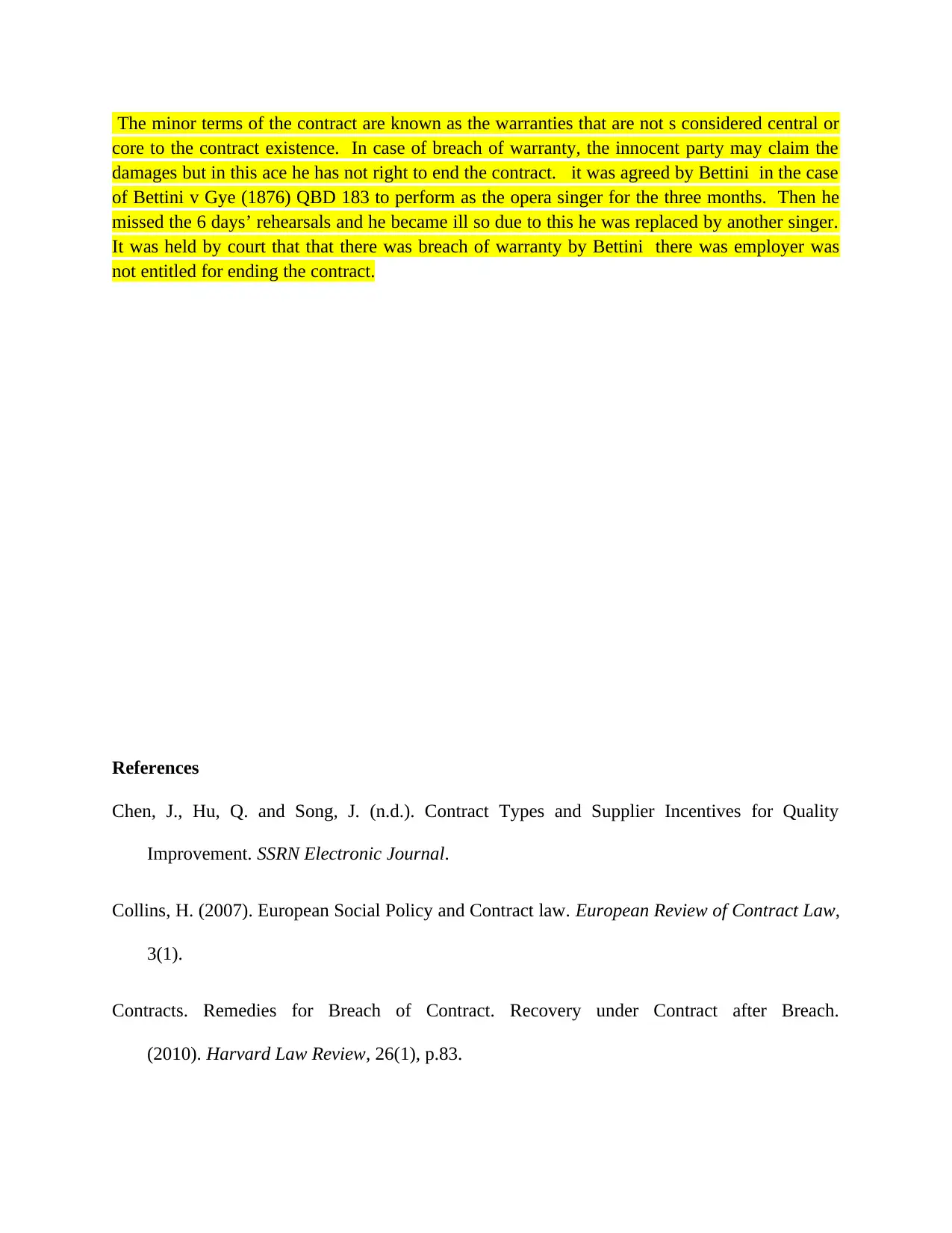
The minor terms of the contract are known as the warranties that are not s considered central or
core to the contract existence. In case of breach of warranty, the innocent party may claim the
damages but in this ace he has not right to end the contract. it was agreed by Bettini in the case
of Bettini v Gye (1876) QBD 183 to perform as the opera singer for the three months. Then he
missed the 6 days’ rehearsals and he became ill so due to this he was replaced by another singer.
It was held by court that that there was breach of warranty by Bettini there was employer was
not entitled for ending the contract.
References
Chen, J., Hu, Q. and Song, J. (n.d.). Contract Types and Supplier Incentives for Quality
Improvement. SSRN Electronic Journal.
Collins, H. (2007). European Social Policy and Contract law. European Review of Contract Law,
3(1).
Contracts. Remedies for Breach of Contract. Recovery under Contract after Breach.
(2010). Harvard Law Review, 26(1), p.83.
core to the contract existence. In case of breach of warranty, the innocent party may claim the
damages but in this ace he has not right to end the contract. it was agreed by Bettini in the case
of Bettini v Gye (1876) QBD 183 to perform as the opera singer for the three months. Then he
missed the 6 days’ rehearsals and he became ill so due to this he was replaced by another singer.
It was held by court that that there was breach of warranty by Bettini there was employer was
not entitled for ending the contract.
References
Chen, J., Hu, Q. and Song, J. (n.d.). Contract Types and Supplier Incentives for Quality
Improvement. SSRN Electronic Journal.
Collins, H. (2007). European Social Policy and Contract law. European Review of Contract Law,
3(1).
Contracts. Remedies for Breach of Contract. Recovery under Contract after Breach.
(2010). Harvard Law Review, 26(1), p.83.
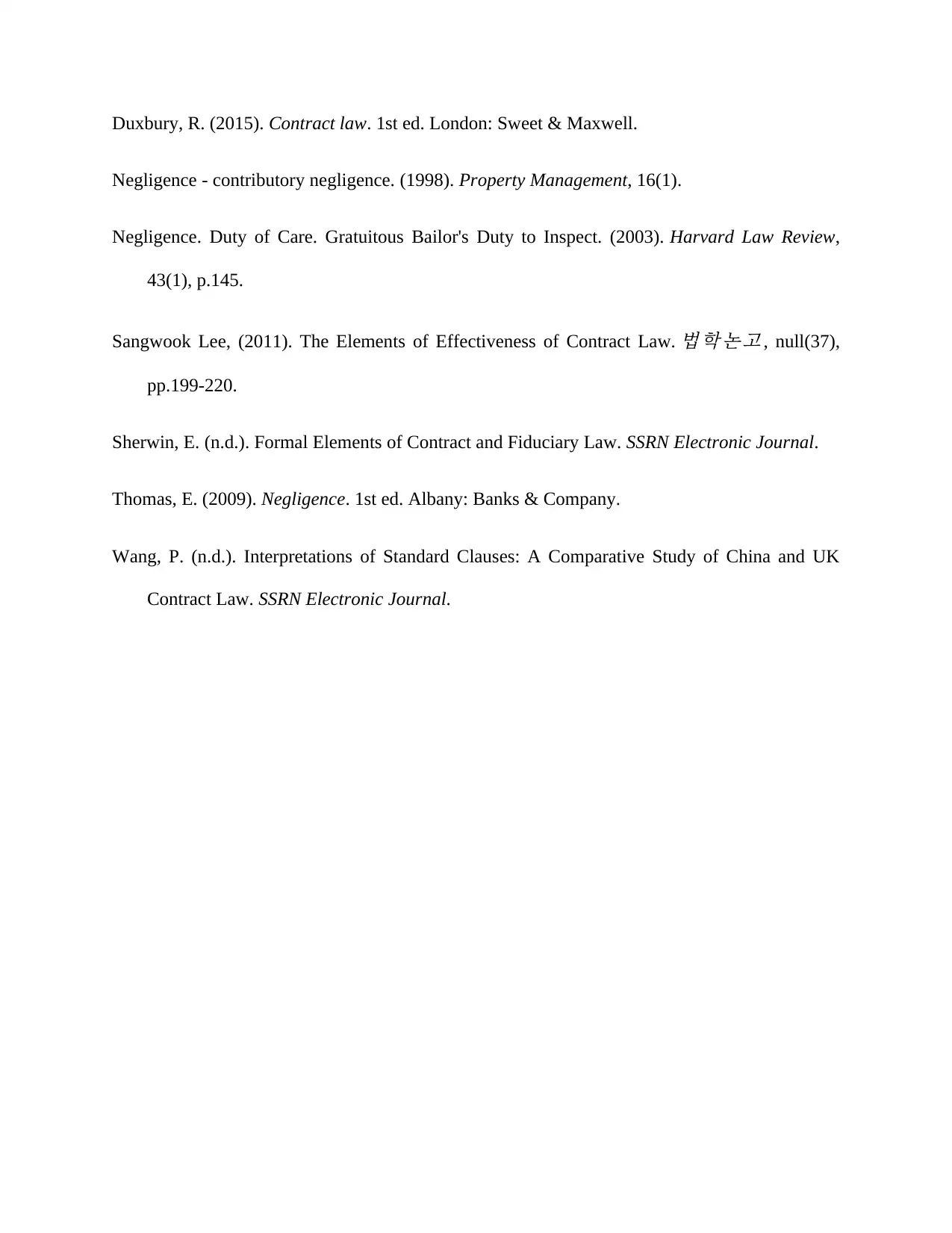
Duxbury, R. (2015). Contract law. 1st ed. London: Sweet & Maxwell.
Negligence - contributory negligence. (1998). Property Management, 16(1).
Negligence. Duty of Care. Gratuitous Bailor's Duty to Inspect. (2003). Harvard Law Review,
43(1), p.145.
Sangwook Lee, (2011). The Elements of Effectiveness of Contract Law.
법 학 논 고 , null(37),
pp.199-220.
Sherwin, E. (n.d.). Formal Elements of Contract and Fiduciary Law. SSRN Electronic Journal.
Thomas, E. (2009). Negligence. 1st ed. Albany: Banks & Company.
Wang, P. (n.d.). Interpretations of Standard Clauses: A Comparative Study of China and UK
Contract Law. SSRN Electronic Journal.
Negligence - contributory negligence. (1998). Property Management, 16(1).
Negligence. Duty of Care. Gratuitous Bailor's Duty to Inspect. (2003). Harvard Law Review,
43(1), p.145.
Sangwook Lee, (2011). The Elements of Effectiveness of Contract Law.
법 학 논 고 , null(37),
pp.199-220.
Sherwin, E. (n.d.). Formal Elements of Contract and Fiduciary Law. SSRN Electronic Journal.
Thomas, E. (2009). Negligence. 1st ed. Albany: Banks & Company.
Wang, P. (n.d.). Interpretations of Standard Clauses: A Comparative Study of China and UK
Contract Law. SSRN Electronic Journal.
1 out of 16
Related Documents
Your All-in-One AI-Powered Toolkit for Academic Success.
+13062052269
info@desklib.com
Available 24*7 on WhatsApp / Email
![[object Object]](/_next/static/media/star-bottom.7253800d.svg)
Unlock your academic potential
© 2024 | Zucol Services PVT LTD | All rights reserved.





